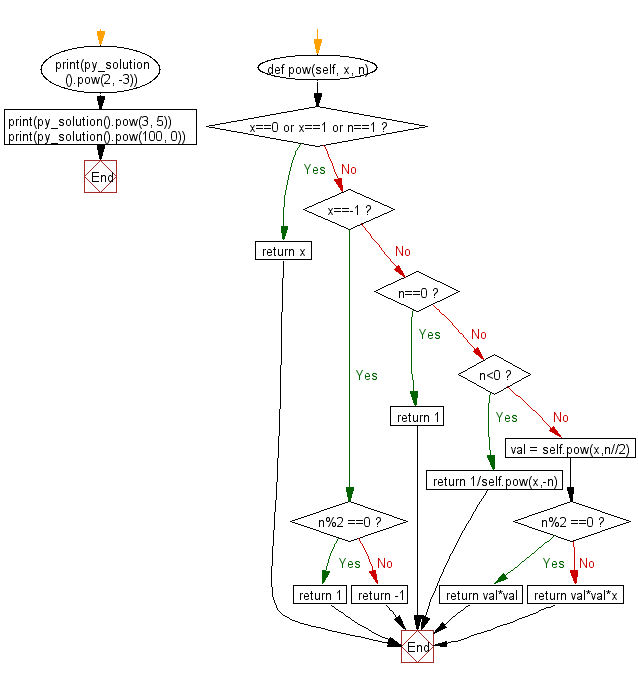Python: Implement pow(x, n)
Python Class: Exercise-7 with Solution
Write a Python class to implement pow(x, n).
Sample Solution:
Python Code:
class py_solution:
def pow(self, x, n):
if x==0 or x==1 or n==1:
return x
if x==-1:
if n%2 ==0:
return 1
else:
return -1
if n==0:
return 1
if n<0:
return 1/self.pow(x,-n)
val = self.pow(x,n//2)
if n%2 ==0:
return val*val
return val*val*x
print(py_solution().pow(2, -3));
print(py_solution().pow(3, 5));
print(py_solution().pow(100, 0));
Sample Output:
0.125 243 1
Pictorial Presentation:
Flowchart:

Visualize Python code execution:
The following tool visualize what the computer is doing step-by-step as it executes the said program:
Python Code Editor:
Contribute your code and comments through Disqus.
Previous: Write a Python class to find the three elements that sum to zero from a set (array) of n real numbers.
Next: Write a Python class to reverse a string word by word.
What is the difficulty level of this exercise?
Test your Programming skills with w3resource's quiz.
Python: Tips of the Day
Find current directory and file's directory:
To get the full path to the directory a Python file is contained in, write this in that file:
import os dir_path = os.path.dirname(os.path.realpath(__file__))
(Note that the incantation above won't work if you've already used os.chdir() to change your current working directory, since the value of the __file__ constant is relative to the current working directory and is not changed by an os.chdir() call.)
To get the current working directory use
import os cwd = os.getcwd()
Documentation references for the modules, constants and functions used above:
- The os and os.path modules.
- The __file__ constant
- os.path.realpath(path) (returns "the canonical path of the specified filename, eliminating any symbolic links encountered in the path")
- os.path.dirname(path) (returns "the directory name of pathname path")
- os.getcwd() (returns "a string representing the current working directory")
- os.chdir(path) ("change the current working directory to path")
Ref: https://bit.ly/3fy0R6m
- New Content published on w3resource:
- HTML-CSS Practical: Exercises, Practice, Solution
- Java Regular Expression: Exercises, Practice, Solution
- Scala Programming Exercises, Practice, Solution
- Python Itertools exercises
- Python Numpy exercises
- Python GeoPy Package exercises
- Python Pandas exercises
- Python nltk exercises
- Python BeautifulSoup exercises
- Form Template
- Composer - PHP Package Manager
- PHPUnit - PHP Testing
- Laravel - PHP Framework
- Angular - JavaScript Framework
- Vue - JavaScript Framework
- Jest - JavaScript Testing Framework
